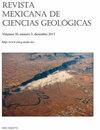断层滑动震级的定量测定:综述
IF 0.5
4区 地球科学
Q4 GEOSCIENCES, MULTIDISCIPLINARY
Revista Mexicana De Ciencias Geologicas
Pub Date : 2023-04-01
DOI:10.22201/cgeo.20072902e.2023.1.1728
引用次数: 0
摘要
在地质学中,断层是一种岩石裂缝,裂缝两侧有明显的相对位移。定量获取断层活动史主要依靠对断层滑动的估计和标志物的研究,可以用来了解和分析断层区的构造演化。断层滑动是通过恢复变形前原本相邻的点来计算的,这些点被称为穿透点。在本文中,我们回顾了一些已发表的确定断层滑动的方法,使用:(1)结构等值线图上的等值线偏移;(2) 地震反射剖面上的偏移;(3) 一个已知的滑动矢量(断层条纹)和一个标记;(4) 两个已知的标记。案例(3)和(4)通常应用于野外工作和地质图。本文章由计算机程序翻译,如有差异,请以英文原文为准。
Quantitative determination of fault slip magnitude: a review
In geology, a fault is a rock fracture with perceptible relative displacement of the opposite sides of the fracture. Quantitatively obtaining the activity history of faults depends mainly on the estimation of fault slip and the study of markers, which can be used to understand and analyze the tectonic evolution of the faulted regions. Fault slip is calculated by restoring points that were originally adjacent before the deformation, those points are named piercing points. In this paper, we review some published methods to determine fault slip, using: (1) the offset of contours on structural contour maps; (2) offset on seismic reflection sections; (3) a known slip vector (fault striae) and one marker; (4) two known markers. Cases (3) and (4) are commonly applied to field work and geological maps.
求助全文
通过发布文献求助,成功后即可免费获取论文全文。
去求助
来源期刊

Revista Mexicana De Ciencias Geologicas
地学-地球科学综合
CiteScore
1.00
自引率
12.50%
发文量
0
审稿时长
6-12 weeks
期刊介绍:
Revista Mexicana de Ciencias Geológicas (RMCG) publishes original research papers on geological processes of broad interest, and particularly those dealing with regions of Latin America. The RMCG also publishes review papers on topics of current interest, and on the geology and tectonics of geological provinces of Latin America. Besides, it offers the opportunity for host editors to publish special thematic issues.
 求助内容:
求助内容: 应助结果提醒方式:
应助结果提醒方式:


